Ferment
Introduction
Text-to-speech Audio
Weighing in at 9 tons, Roxy Paine’s Ferment took more than two weeks to install at the Nelson-Atkins Museum of Art. The 56-foot tall, stainless steel sculpture was created in Paine’s New York studio using cylindrical pipes and rods, then delivered in pieces and welded together on site. Taking from the literal definition of ferment, Paine tried to “create a churning, swirling force” within the 35-foot span of branches. Classified as a dendroid, the polished, twisted branches of Ferment capture the juxtaposition of industry and nature, instigating thought amongst its viewers. A gift of the Hall Family Foundation in honor of art consultant Martin Friedman’s retirement, Ferment was installed in April 2011.
Images
Ferment by Roxy Paine at the Nelson-Atkins Museum of Art, Kansas City, Missouri

The installation of Ferment on site at The Nelson took more than two weeks

Artist Roxy Paine geared up to weld

Roxy Paine (1966- )

Backstory and Context
Text-to-speech Audio
New York artist Roxy Paine (1966- ) attended Pratt Institute and worked at a fabrication shop in Brooklyn, New York before he started exhibiting his art there in 1990. Two years later he opened his own studio in Treadwell, New York and now has collections around the world. Paine developed an early interest in human impulse creating control over the forces of nature and often uses materials and methods that are considered unpleasant by many. Industry and natural objects became a vital part of his early work, like creating replicas of hallucinogenic plants and machines that produced questionable objects. In the early 2000s his ideals evolved into the collapse of industry on nature as seen in his dendroids, structures having branch-like features, which developed further into an interest in the structure of the brain and nervous systems. He says, “calling them [dendroids] trees, is selling it short.”
Commissioned in 2009 by the Hall Family Foundation, Roxy Paine was chosen by Martin Friedman, a long-time art consultant for the foundation and sculpture park, to create a piece in honor of his retirement. Friedman was an admirer of Paine for some time and described his work as, “elegance and force and power in the sculpture; they play beautifully together and against each other.” Influenced by the material’s industrial use, Paine often uses stainless steel for his sculptures. Taking two years to construct, pieces of cylindrical pipe and rods were cut, welded together, and grinded smooth to create this 56-foot tall dendroid, called Ferment.
The installation of Ferment was led by the McCownGordon construction firm. First, nine rock anchors were drilled 30 feet into the bedrock and 36,000 pounds of concrete was poured to construct a foundation that could support the 9-ton sculpture. In addition, roads and pads had to be built in order to get the sculpture to its chosen location, on the top of the hillside of the south lawn. Due to its size, Ferment was transported from New York in several pieces. The installation itself took more than two weeks to complete, from April 9th to 28th, as the steel pieces were lifted by cranes and welded together on site.
Coinciding with the installation of Ferment on the south lawn, Paine was featured in a solo exhibition inside the Bloch Lobby called Roxy Paine: Scumaks and Dendroids. For the exhibition, two models of his dendroids were on display alongside the Scumak, short for sculpture maker, which actively produced plastic sculptures for five months. More than 40 small, Scumak sculptures were created, three of which were donated to The Nelson following the exhibition.
Gallery Label Description
Rising 56 feet into the air with a branching system that spans 35 feet, Roxy Paine's silvery sculpture, Ferment, acknowledges the power of human imagination and technological innovation. At the same time, its organic, tree-like form speaks profoundly to the dendritic (branching) structures of nature-from our bodies (torso, arms, hands, fingers) to vascular and neurological systems to river deltas and erosion patterns to botanical branching. Ferment, one of more than 20 dendroid sculptures by Paine, investigates this complex interrelationship between nature and technology.
"Ferment" is defined as a state of agitation or turbulent change. With its twisting, gnarled branches, Paine's sculpture embodies the surging energy of creation, growth, transformation, decay and regeneration.
Sources
Ferment, The Nelson-Atkins Museum of Art. Accessed September 21st, 2022. https://art.nelson-atkins.org/objects/56321/ferment.
Mason, Randy. Putting Down Roots: Roxy Paine's Ferment , April 15th, 2012. Accessed September 21st, 2022. https://kcstudio.org/putting-down-roots-roxy-paines-ferment/.
About, Roxy Paine. Accessed September 21st, 2022. http://roxypaine.com/about.
Roxy Paine's Ferment to be Installed in Kansas City Sculpture Park, The Nelson-Atkins Museum of Art. January 14th, 2010. Accessed September 21st, 2022. https://www.nelson-atkins.org/roxy-paines-ferment/.
Nelson-Atkins Museum of Art retains three scumak sculptures by Roxy Paine, Art Daily. Accessed September 21st, 2022. https://artdaily.cc/news/50088/Nelson-Atkins-Museum-of-Art-retains-three-scumak-sculptures-by-Roxy-Paine#.YypBi3bMLIU.
Project Case Study: The Nelson-Atkins Museum of Art, McCownGordon Construction. Accessed September 21st, 2022. https://mccowngordon.com/project/nelson-atkins-museum-of-art-2/.
Photo by David Trowbridge
https://kcstudio.org/putting-down-roots-roxy-paines-ferment/
https://www.nga.gov/features/slideshows/roxy-paine-graft.html
https://www.huffpost.com/entry/magic-mushrooms-and-a-tre_b_768446
